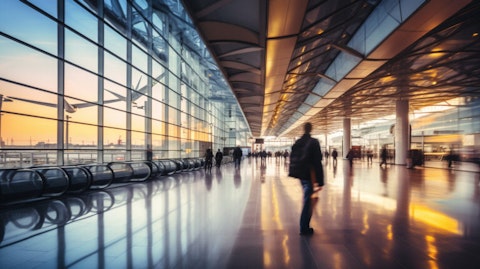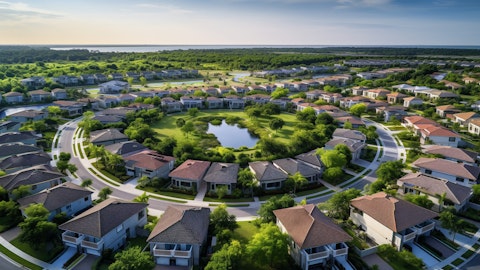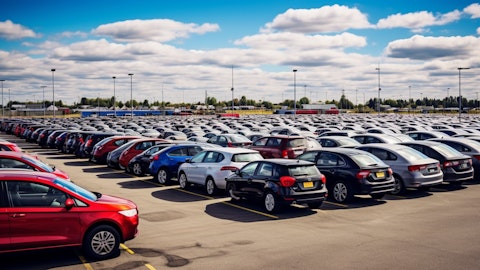In this article, we will be taking a look at the 20 worst airports in the U.S. To skip our detailed analysis, you can go directly to see the 5 worst airports in the U.S.
According to IBIS World, U.S. airport operations have suffered significantly in the last five years, falling at a CAGR of 3.4% in the same time period and the industry was worth just $12.9 billion in 2023. Unsurprisingly, the biggest driver behind this decline is the Covid-19 pandemic, which wreaked havoc on the travel industry, and even 2 years later, the airline industry is still attempting to recover.
The U.S. airline industry is finally returning to profitability, benefitting massively from significant increases in the price of tickets. This trend is reflected in the International Air Transport Association’s airline profitability outlook, which said that total airline industry net profits would reach nearly $9.8 billion by the end of 2023, resulting in a net margin of just 1.2%, though this is still more than double of an earlier forecast, which saw net profits landing at $4.7 billion. Meanwhile, operating profits are set to increase even further and land at over $22 billion in 2023, which just goes to show how capital intensive the airline industry is, with fixed costs eating up into profits.

A busy airport terminal, highlighting the company’s strong transportation arm. Editorial photo for a financial news article. 8k. –ar 16:9
As airline recovers, so will airports, though the worst airports in the U.S. could still see less footfall as people avoid these airports to save on time and avoid misery. Airports are already stressful places to be at, because of inconvenient security checks, strict staff and the stress of possibly missing flights, and the worst airports in the world just make it an even more miserable experience. While the worst airports in the America need to improve significantly, they are still much better than the worst airports in the world. The Benazir Bhutto International Airport in Islamabad, Pakistan ranked as the worst previously but the country’s Civil Aviation Authority built a much bigger one with better facilities, and now it’s nowhere near the top 10 worst airports in the world. In fact, that distinction belongs to, surprisingly, the Toronto Pearson International Airport, according to AirHelp, with survey reporting that many passengers were put off by the confusion and chaos, while overcrowding was considered to be a serious issue.
Overcrowding may very well be a major factor once again, as was evidenced in 2022, especially in the U.S. and Europe, when airports laid off tens of thousands of headcount and were left monumentally short-staffed and some of the worst airports in the U.S. struggled more than most with delays, cancellations and strikes all creating more problems for airlines and airports. The situation was similar in Europe, where London Heathrow Airport, one of the busiest airports in the world, limited passengers to 100,000 per day, a move that saw heavy pushback from airlines bosses, including the CEO of Emirates Airline, one of the most profitable airlines in the world. At the same time, it is important to remember that most airports, especially in the U.S., are owned by the state or local governments, and hence, aren’t accountable to shareholders, nor are profits the primary motivation. Even then, some airports, which maximize efficiency, and all 5 of the most profitable airports in the world are located in the U.S. However, the best airports in the world are generally located in Asia, with Singapore’s Changi Airport named the best airport globally by Skytrax World Airport Awards, followed by Qatar’s Doha Hamad International Airport and Japan’s Tokyo Haneda International Airport. The U.S. has no entries even in the top 10.
Right now, the airline industry is feeling really positive, even as travelling trends are changing. Covid-19 has significantly changed consumer trends, particularly with respect to travel, and airlines need to adapt accordingly and change strategy as needed. If airlines make incorrect predictions with respect to estimating the best time to sell seats, their margins can dip, which in a low margin industry struggling towards profitability can be dangerous. Correct estimations also allow airports to estimate footfall and react accordingly, and better forecast accuracy could result in the worst airports in the U.S. seeing their ratings improve too. Currently, business travel is continuing to increase once again as the focus on meeting face to face has seen an increase, while rewards programs and utilization of tech to create a smoother experience for airlines is a big sell too. This was called out by the CEO of American Airlines Group Inc. (NASDAQ:AAL) in the company’s Q3 2023 earnings call, stating “During the third quarter, we saw year-over-year growth in corporate and government revenue, with a return to more traditional seasonality trends. We remain encouraged by what we’re seeing with demand and revenue from unmanaged business travel. Importantly, more customers than ever are choosing our Travel Rewards program by acquiring our co-brand credit cards in record numbers, enrolling in the Advantage program, and shopping for our product through our direct channels. Co-brand mileage sales growth continues to outpace airline capacity and GDP growth, driving increased levels of loyalty and revenue production from card users. In the third quarter, approximately 80% of our bookings came from our own channels and modern retailing technology, which is up approximately 11 points from a year ago. These are the most efficient distribution channels in our ecosystem, and we expect to see these trends continue into the fourth quarter and beyond.”
However, despite the optimist, American Airlines Group Inc. (NASDAQ:AAL) has seen its YTD share price drop by 13%. Similarly, Delta Air Lines, Inc. (NASDAQ:DAL) has seen its share price barely change YTD 2023 despite its revenue increasing from nearly $30 billion in 2021 to over $50 billion in 2022, while net income increased from $280 million to $1.3 billion in the same time period.
Here’s what Patient Capital Management said about Delta Air Lines, Inc. (NYSE:DAL) in its second-quarter 2023 investor letter:
“We like other names mostly ignored by the market for similar reasons. Names like Expedia (EXPE), General Motors (GM) and Delta Air Lines, Inc. (NYSE:DAL). These companies have strong returns on capital (14%+), good competitive positions, cheap valuations (all double-digit free cash flow yields), and are returning capital to shareholders. We trust the managements to take advantage of their depressed stock prices and create long-term shareholder value.”
Ed Bastian, the CEO of Delta Air Lines, Inc. (NYSE:DAL), stated in the company’s Q2 2023 earnings call “Demand for premium experiences, international travel, and increasing business travel further differentiate the trends that Delta is seeing within the industry. We expect our December quarter revenues to be 10% higher than 2022 with a 10% operating margin and earnings of over $1 per share. This brings our expectation for full-year earnings to over $6 per share on a double-digit operating margin and free cash flow of $2 billion. Since raising full-year guidance over the summer, our revenue outlook has improved, though earnings and cash flow have been impacted by higher fuel and maintenance costs. Revenue for the full year is expected to increase 20% over last year, which was the high end of our expectations on steady domestic demand and continued strength in international. With strong top-line growth and margin expansion, we expect to double earnings year over year and deliver a 13% return on invested capital.”
Methodology
To determine the worst airports in the U.S., we relied on rankings conducted by JD Power, which ranked around 60 airports in the country as well as rankings carried out by WSJ. We then double-checked this based on survey on Reddit, to ensure that the most popular worst airports there were being considered too. The best airport in the U.S., was the Indianapolis International Airport. So let’s now take a look at the airports which people prefer to avoid as applicable. Surprisingly, despite increasing passenger volumes, North American airports actually saw overall satisfaction increase after improvements made in baggage claim, retail and beverage service, and terminal facilities.
20. Orlando International Airport
Orlando International Airport had the worst on-time arrival performance of any airport in the country, as only 68.3% of flights arrived or departed on time.
19. Denver International Airport
A relatively younger airport having been established in 1995, the airport transports around a million people every year to Las Vegas and Phoenix.
18. Hartsfield-Jackson Atlanta International Airport
Hartsfield-Jackson Atlanta International Airport is the busiest airport in the world, and is about to embark on significant parking changes, which are likely to cause issues at least in the beginning.
17. San Jose International Airport
The troubles pertaining to San Jose International Airport begin even before reaching the airport due to terrible traffic and congestion, while the security lines are said to be too long and time consuming.
16. George Bush Intercontinental Airport
The busiest international airport in Texas, George Bush Intercontinental Airport has been ranked among the worst airports in the U.S. with complaints targeting poor navigation within the airport even as construction continues which is expected to cost around $1.2 billion.
15. Lambert-St. Louis International Airport
The Lambert-St. Louis International Airport has struggled with lower traffic ever since Trans World Airlines went under, and even then, baggage claim takes longer than most airports, according to some.
14. John F. Kennedy International Airport
One of the most famous airports in the world, New York’s John F. Kennedy International Airport has some of the highest passenger numbers in the country too, most of whom expect a better experience in the airport.
13. Hollywood Burbank Airport
Hollywood has two airports among the worst in the U.S. with the majority of travelers stating that the airport is too overcrowded.
12. San Diego International Airport
Around 50,000 passengers traverse through San Diego International Airport every single day and has an economic impact of around $12 billion. If improvements aren’t made soon, the impact of San Diego’s airport not having the requisite facilities could be significant.
11. Charlotte Douglas International Airport
The Charlotte Douglas International Airport is both a military and civilian airport which primarily serves the Charlotte Metropolitan Area.
10. Kahului Airport
Kahului Airport has long been considered one of the worst airports in America, with many complaining about the lack of availability of gates to deplane from even after the plane has landed, creating additional delays and hassle.
9. Phoenix Sky Harbor International Airport
Located close to the city of Arizona, Phoenix Sky Harbor International Airport is Arizona’s largest airport and one of the busiest in America.
8. Oakland International Airport
The lack of facilities have made Oakland International Airport rank among the worst airports in the U.S. Queueing lines, cleanliness and seating facilities have all received poor reviews from flyers.
7. Chicago O’Hare International Airport
One of the busiest airports in the world, Chicago O’Hare International Airport has seen frequent delays mainly because its location sees frequent weather disturbances.
6. Fort Lauderdale-Hollywood International Airport
Fort Lauderdale saw the third-worst performance in the U.S. in terms of flights delayed, which recently got flooded after exceptionally heavy rates in the area.
Click to continue reading and see 5 Worst Airports in the U.S.
Suggested Articles:
- Top 15 Chinese Companies on US Exchanges
- 13 Best Alternative Energy Stocks To Buy Now
- 11 Best Low-Risk Dividend Stocks To Invest In
Disclosure: None. 20 worst airports in the U.S. is originally published on Insider Monkey.





